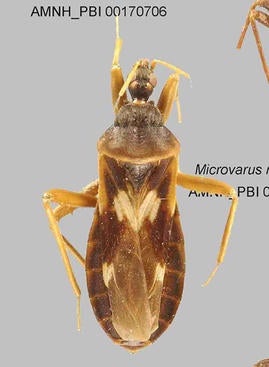Lobe-headed Bugs: Pseudocetherinae
In 1963, Villiers described the genus Pseudocethera and he erected a new subfamily, Pseudocetherinae, to accommodate it. The systematic position of the genus, which currently contains three species, was modified subsequently by different authors; some placed it in Cetherinae, others retained the subfamily Pseudocetherinae. Re-examination of Pseudocethera clarified that the genus differs rather sharply from both Cetherinae and “Reduviinae sensu stricto” (= the monophyletic line, which contains Reduvius, within the current, probably not monophyletic Reduviinae or “Reduviinae sensu lato”). Therefore, its inclusion in a separate subfamily seems justified.
Examination of several genera currently placed in “Reduviinae sensu lato” revealed that a number of them are closely related with Pseudocethera and should therefore be included in Pseudocetherinae. Some preliminary results of this revision in progress are summarized below.
(1) Microvarus Jeannel (currently 2 spp., West Africa and Fernando Poo), Voconia Stål (1 sp., Australia), Paragerbelius Miller (1 sp., New Guinea), and Kayanocoris Miller (1 sp., Borneo) should be transferred to Pseudocetherinae.
(2) Gerbelius Distant (3 spp., India, Malaysia, Myanmar) is probably polyphyletic, part of the species seem to belong to the Pseudocetherinae.
(3) Specimens representing several undescribed taxa have been discovered and are currently under examination. Some of these undescribed species of Pseudocetherinae occur in Mexico, Trinidad, and Honduras, which extends the known range of Pseudocethera and allies to the New World.
(4) Judging from preliminary examination, the majority of the undescribed specimens can be placed in Microvarus. As a result, this genus, currently containing only one species from West Africa and one from Fernando Poo, appears to have circumtropical distribution, with species occuring in Middle America, Africa, South- and South-eastern Asia, the Malay Archipelago, and probably also in Australia. Part of Gerbelius should also be transferred to Microvarus.
